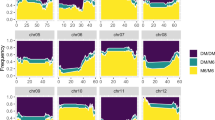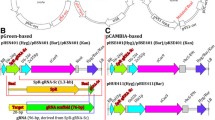Abstract
The Lotus japonicus LjSYM2 gene, and the Pisum sativum orthologue PsSYM19, are required for the formation of nitrogen-fixing root nodules and arbuscular mycorrhiza. Here we describe the map-based cloning procedure leading to the isolation of both genes. Marker information from a classical AFLP marker-screen in Lotus was integrated with a comparative genomics approach, utilizing Arabidopsis genome sequence information and the pea genetic map. A network of gene-based markers linked in all three species was identified, suggesting local colinearity in the region around LjSYM2/PsSYM19. The closest AFLP marker was located just over 200 kb from the LjSYM2 gene, the marker SHMT, which was converted from a marker on the pea map, was only 7.9 kb away. The LjSYM2/PsSYM19 region corresponds to two duplicated segments of the Arabidopsis chromosomes AtII and AtIV. Lotus homologues of Arabidopsis genes within these segments were mapped to three clusters on LjI, LjII and LjVI, suggesting that during evolution the genomic segment surrounding LjSYM2 has been subjected to duplication events. However, one marker, AUX-1, was identified based on colinearity between Lotus and Arabidopsis that mapped in physical proximity of the LjSym2 gene.



Similar content being viewed by others
References
Arumuganathan K, Earle ED (1991) Nuclear DNA content of some important plant species. Plant Mol Biol Rep 9:208–218
Blanc G, Barakat A, Guyot R, Cooke R, Delseny I (2000) Extensive duplication and reshuffling in the Arabidopsis genome. Plant Cell 12:1093–1101
Blanc G, Hiokamp K, Wolfe KH (2003) A recent polyploid superimposed on older large-scale duplications in the Arabidopsis genome. Genome Res 13:137–144
Borisov AY, Madsen LH, Tsyganov VE, Umehara Y, Voroshilova VA, Batagov AO, Sandal N, Mortensen A, Schauser L, Ellis N, Tikhonovich IA, Stougaard J (2003) The Sym35 gene required for root nodule development in Pea is an ortholog of Nin from Lotus japonicus. Plant Physiol 131:1009–10017
Carroll BJ, McNeil DL, Gresshoff PM (1985). Isolation and properties of soybean glycine-max (L) Merr mutants that nodulate in the presence of high nitrate concentrations. Proc Natl Acad Sci USA 82:4162–4166
Cyranoski D (2001) Japanese legume project may help to fix the nitogen problem. Nature 409:272
Dehmer KJ (2001) Conclusions on the taxonomy of the Solanum nigrum complex by molecular analyses of IPK germplasm accessions. In: van den Berg RG, Barendse GWM, van der Weerden GM, Mariani C (eds) Solanaceae V: Advances in taxonomy and utilization. Proc Vth Int Solanaceae Conference, July 23–29th (2000), Nijmegen. Nijmegen University Press, pp 85–96
Duc G, Messager A (1989) A mutagenesis of pea (Pisum sativum L.) and the isolation of mutants for nodulation and nitrogen fixation. Plant Sci 60:207–213
Duc G, Trouvelot A, Gianinazzi-Pearson V, Gianinazzi S (1989) First report of non-mycorrhizal plant mutants (myc−) obtained in pea (Pisum sativum L.) and faba bean (Vicia faba L.). Plant Sci 60:215–222
Endre G, Kereszt A, Kevei Z, Mihacea S, Kaló P, Kiss GB (2002) A receptor kinase gene regulating symbiotic nodule development. Nature 417:962–966
Flemetakis E, Kavroulakis NEM, Quaedvlieg HP, Spaink HP, Dimou M, Roussis A, Katinakis P (2000) L. japonicus contains two distinct ENOD40 genes that are expressed in symbiotic, nonsymbiotic, and embryonic tissues. Mol Plant-Microbe Interact 13:987–994
Gandolfo MA, Nixon KC, Crepet WL (1998) A new fossil flower from the Turonian of New Jersey: Dressiantha bicarpellata gen. et sp. nov. (Capparales). Am J Bot 85:964–974
Giovannoni JJ, Wing RA, Ganal MW, Tanksley SD (1991) Isolation of molecular markers from specific chromosomal intervals using DNA pools from existing mapping populations. Nucleic Acids Res 19:6553–6558
Grant D, Cregan P, Shoemaker RC (2000) Genome organization in dicots: genome duplication in Arabidopsis and synteny between soybean and Arabidopsis. Proc Natl Acad Sci USA 97:4168–4173
Gualtieri G, Kulikova O, Limpens E, Kim DJ, Cook DR, Bisseling T, Geurts R (2002) Microsynteny between pea and Medicago truncatula in the SYM2 region. Plant Mol Biol 50:225–235
Kawaguchi M, Motomura T, Imaizumi-Anraku H, Akao S, Kawasaki S (2001) Providing the basis for genomics in L. japonicus: the accessions Miyakojima and Gifu are appropriate crossing partners for genetic analyses. Mol Genet Genomics 266:157–166
Krusell L, Madsen LH, Sato S, Aubert G, Genua A, Szczyglowski K, Duc G, Kaneko T, Tabata S, de Bruijn F, Pajuelo E, Sandal N, Stougaard J (2002) Shoot control of root development and nodulation is mediated by a receptor-like kinase. Nature 420:422–426
Laucou V, Haurogne K, Ellis N, Rameau C (1998) Genetic mapping in pea. 1. RAPD-based genetic linkage map of Pisum sativum. Theor Appl Genet 97:905–915
Michaelson MJ, Price HJ, Ellison JR, Johnston JS (1991) Comparison of plant DNA contents determined by Feulgen microspectrophotometry and laser flow-cytometry. Am J Bot 78:183–188
Michelmore RW, Paran I, Kesseli RV (1991) Identification of markers linked to disease-resistance genes by bulked segregant analysis—a rapid method to detect markers in specific genomic regions by using segregating populations. Proc Nat Acad Sci USA 88:9828–9832
Nishimura R, Hayashi M, Wu GJ, Kouchi H, Imaizumi-Anraku H, Murakami Y, Kawasaki S, Akao S, Ohmori M, Nagasawa M, Harada K, Kawaguchi M (2002) HAR1 mediates systemic regulation of symbiotic organ development. Nature 420:426–429
Pedrosa A, Sandal N, Stougaard J, Schweizer D, Bachmair A (2002) Chromosomal map of the model legume Lotus japonicus. Genetics 161:1661–72
Sandal N, Krusell L, Radutoiu S, Olbryt M, Pedrosa A, Stracke S, Parniske M, Bachmair A, Ketelsen T, Stougaard J (2003) An AFLP-based genetic linkage map of the model legume L. japonicus developed from an interspecific F2 mapping population. Genetics (in press)
Sato S, Kotani H, Nakamura Y, Kaneko T, Asamizu E, Fukami M, Miyajima N, Tabata S (1997) Structural analysis of Arabidopsis thaliana chromosome 5. I. Sequence features of the 1.6-Mb regions covered by 20 physically assigned P1 clones. DNA Res 4:215–230
Sato S, Kaneko T, Nakamura Y, Asamizu E, Kato T, Tabata S (2001) Structural analysis of a L. japonicus genome. I. Sequence features and mapping of 56 TAC clones which cover the 5.4 Mb regions of the genome. DNA Res 8:311–318
Schauser L, Handberg N, Sandal N, Stiller J, Thykjaer T, Pajuelo E, Nielsen A, Stougaard J (1998) Symbiotic mutants deficient in nodule establishment identified after T-DNA transformation of L. japonicus. Mol Gen Genet 259:414–423
Schneider A, Walker SA, Poyser S, Sagan M, Ellis THN, Downie JA (1999) Genetic mapping and functional analysis of a nodulation- defective mutant (sym19) of pea (Pisum sativum L.). Mol Gen Genet 262:1-11
Searle IR, Men AE, Laniya TS, Buzas DM, Iturbe-Ormaetxe I, Carroll BJ, Gresshoff PM (2003) Long-distance signaling in nodulation directed by a CLAVATA1-like receptor kinase. Science 299:109–112
Shoemaker RC, Polzin K, Labate J, Specht J, Brummer EC, Olson T, Young N, Concibido V, Wilcox J, Tamulonis JP, Kochert G, Boerma HR (1996) Genome duplication in soybean (Glycine subgenus soja). Genet 144:329–338
Siebert PD, Chenchik A, Kellogg DE, Lukyanov KA, Lukyanov SA (1995) An improved PCR method for walking in uncloned genomic DNA. Nucleic Acids Res 23:1087–1088.
Staden R (1996) The Staden sequence analysis package. Mol Biotechnol 5:233–241
Steiner JJ, Poklemba CJ, Fjellstrom RG, Elliott LF (1995) A rapid one-tube genomic DNA extraction process for PCR and RAPD analyses. Nucleic Acids Res 23:2569–2570
Stracke S, Kistner C, Yoshida S, Mulder L, Sato S, Kaneko T, Tabata S, Sandal N, Stougaard J, Szcyglowski K, Parniske M (2002) A plant receptor-like kinase required for both bacterial and fungal symbiosis. Nature 417:959–962
Sullivan JT, Ronson CW (1998) Evolution of rhizobia by acquisition of a 500-kb symbiosis island that integrates into a phe-tRNA gene. Proc Natl Acad Sci USA 95:9059–9059
The Arabidopsis Genome Initiative (2000) Analysis of the genome sequence of the flowering plant Arabidopsis thaliana. Nature 408:796–815
Thoquet P, Gherardi M, Journet EP, Kereszt A, Ane JM, Prosperi JM, Huguet T (2002) The molecular genetic linkage map of the model legume Medicago truncatula: an essential tool for comparative legume genomics and the isolation of agronomically important genes. BMC Plant Biol 2:1
Turner SR, Hellens R, Ireland R, Ellis N, Rawsthorne S (1993) The organization and expression of the genes encoding the mitochondrial glycine decarboxylase complex and serine hydroxymethyltransferase in Pea (Pisum sativum). Mol Gen Genetics 236:402–408
Vision TJ, Brown DG, Tanksley SD (2000) The origins of genomic duplications in Arabidopsis. Science 290:2114–2117
Vos P, Hogers R, Bleeker M, Reijans M, Vandelee T et al. (1995) AFLP—a new technique for DNA-fingerprinting. Nucleic Acids Res 23:4407–4414
Wegel E, Schauser L, Sandal N, Stougaard J, Parniske M (1998) Mycorrhiza mutants of L. japonicus define genetically independent steps during symbiotic infection. Mol Plant-Microbe Interact 11:933–936
Wolfe KH, Li W-H (2003) Molecular evolution meets the genomics revolution. Nature Genet 33:255–265
Ziolkowski PA, Blanc G, Sadowski J (2003) Structural divergence of chromosomal segments that arose from successive duplication events in the Arabidopsis genome. Nucleic Acids Res 31:1339–1350
Acknowledgements
We thank Thomas Lahaye for useful discussions and Satoko Yoshida, Kate Vickers and Julia Mattner for critical reading of the manuscript. We thank Jillian Perry, Jodie Pike and Julia Schmitz for help with recombinant screens, David Baker, Patrick Bovil and Nigel Hartley for shotgun sequencing of BAC 8M6 and Sara Perkins and Fiona Alderson for plant care. Research at the Sainsbury Laboratory is supported by the Gatsby Charitable Foundation.
Author information
Authors and Affiliations
Corresponding author
Additional information
Communicated by J.S. Heslop-Harrison
Rights and permissions
About this article
Cite this article
Stracke, S., Sato, S., Sandal, N. et al. Exploitation of colinear relationships between the genomes of Lotus japonicus, Pisum sativum and Arabidopsis thaliana, for positional cloning of a legume symbiosis gene. Theor Appl Genet 108, 442–449 (2004). https://doi.org/10.1007/s00122-003-1438-2
Received:
Accepted:
Published:
Issue Date:
DOI: https://doi.org/10.1007/s00122-003-1438-2




